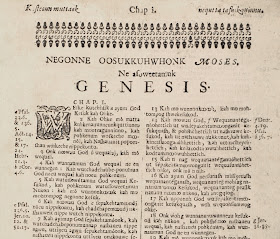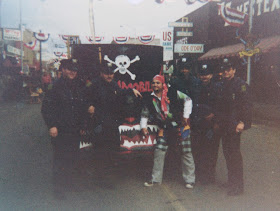 If someone handed you the first Bible printed in America, you might be surprised to find that it was written not in English, but in Massachusett, an Algonquian language. Published in 1663, the Eliot Bible is one of the many treasures at Rauner Library and an example of the use of written word as a means of evangelism in American history.
If someone handed you the first Bible printed in America, you might be surprised to find that it was written not in English, but in Massachusett, an Algonquian language. Published in 1663, the Eliot Bible is one of the many treasures at Rauner Library and an example of the use of written word as a means of evangelism in American history.John Eliot, the "Indian Apostle," came to America from England in 1631 with the goal of preaching in the New World. Although he first worked with the young colonists, the idea of evangelizing the natives was never far from his mind; he wrote, "I do very much desire to translate some parts of the Scriptures into their language and print some Primer in their language where to initiate and teach them to read." Eliot's ambition, says Cotton Mather, was to fulfill the words of the Massachusetts Royal Charter "To win and incite the Natives of that Country to the knowledge and obedience of the only true God and Saviour of Mankind, and the Christian Faith."
Eliot began this mission by regularly visiting the nearby Massachusett tribe for three or four days at a time, learning their language and teaching them his. With this knowledge, Eliot began the task of translating the Bible into the native Massachusett tongue, phonetically, using the English written language – a feat that took him ten years. This was also the first time that a Native American tongue had been given an alphabet and a written language.
The translation would not have been possible without the help of John Sassamon, a member of the local tribe who could speak and write English. Sassamon was adopted by an English family after his own family succumbed to disease (most likely brought by the Europeans). Sassamon would later go on to be the first Native American to attend Harvard University.
One thousand copies of Eliot's "Indian Bible" were printed under the full title "The Holy Bible Containing the Old Testament and the New Translated into the Indian Language," by Samuel Green of Cambridge. It would take about 120 years until the first complete English edition of the Bible would be printed in America.
The main goal of the printing of the Eliot Bible was not to give Native Americans a Bible of their own, but to give English preachers a means to communicate the Word of God to the natives. The importance of the Bible today is not textual accuracy, but rather it is an emblem of early Colonial and Native American history.
Come by Rauner to see the "Eliot Bible" and hold a part of the history of America. Ask for: Rare BS345 .A2 E4 1663
Posted for Thea Stutsman, '13



